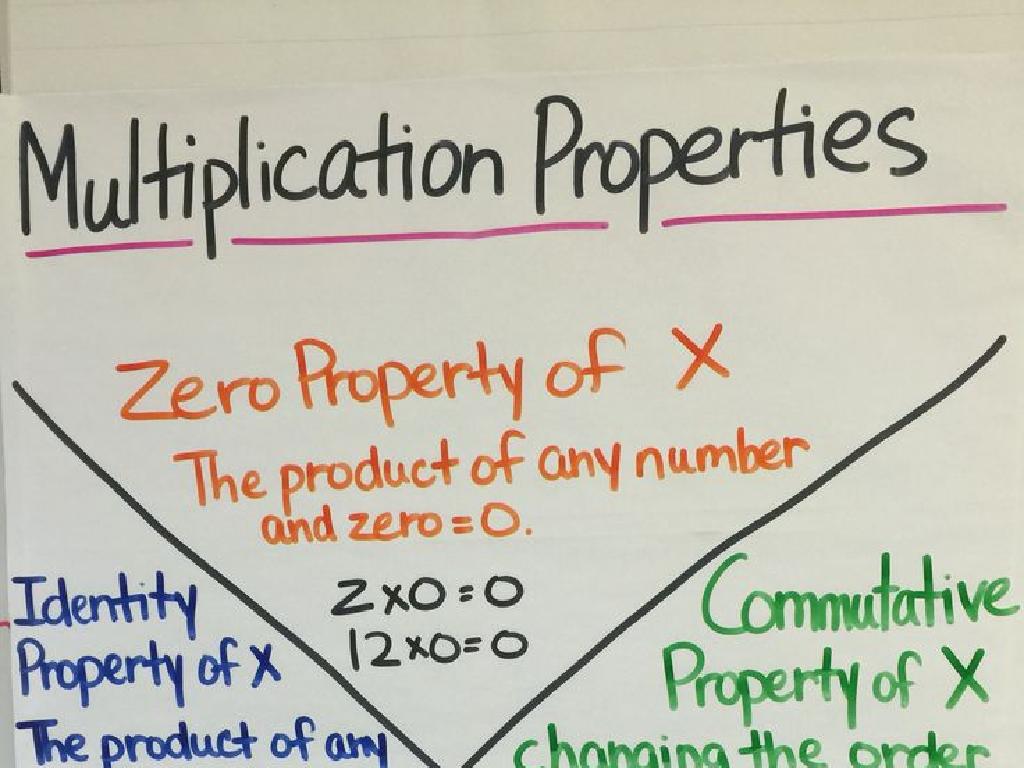Scaling Whole Numbers By Fractions: Justify Your Answer
Subject: Math
Grade: Fifth grade
Topic: Scaling By Fractions
Please LOG IN to download the presentation. Access is available to registered users only.
View More Content
Scaling Whole Numbers by Fractions
– Grasping the concept of fractions
– Fractions represent parts of a whole, like 1/2 of a pizza
– Exploring the meaning of scaling
– Scaling means to resize something, like using a model to represent a larger object
– Combining fractions with scaling
– When we scale with fractions, we’re adjusting the size by a fractional part
– Justifying scaled answers
– Use examples to show how scaling affects numbers and why the result makes sense
|
This slide introduces the concept of scaling whole numbers by fractions, a fundamental skill in understanding proportions and mathematical relationships. Begin by ensuring students have a solid understanding of fractions as parts of a whole. Then, explain scaling as the process of increasing or decreasing the size of an item. Show how fractions can be used to scale whole numbers, effectively resizing them. Emphasize the importance of being able to justify the reasoning behind the scaled answers, which reinforces comprehension. Provide examples such as scaling recipes or objects in drawings to make the concept relatable and easier to grasp.
Recap: Understanding Fractions
– A fraction shows part of a whole
– Like a slice of pizza is part of a whole pizza
– Numerator over denominator
– Examples: 1/2, 3/4, 5/8
– 1/2 means 1 out of 2 equal parts, 3/4 means 3 out of 4 equal parts
– Visualize with pie charts
– Draw pie charts to see fractions visually
|
Begin with a quick review of what a fraction is, emphasizing that it represents a part of a whole, such as a slice of pizza out of an entire pizza. Highlight the components of a fraction: the numerator (top number) indicates how many parts we have, while the denominator (bottom number) shows the total number of equal parts the whole is divided into. Provide clear examples of fractions and use visual aids like pie charts to help students visualize and better understand the concept. This foundational knowledge is crucial for grasping the upcoming lesson on scaling whole numbers by fractions.
Understanding Scaling with Fractions
– Scaling changes size
– Math scaling alters numbers
– Example: Multiplying by 2
– Doubling a number, e.g., 3 x 2 = 6
– Example: Dividing by 2
– Halving a number, e.g., 6 ÷ 2 = 3
|
This slide introduces the concept of scaling in mathematics, which is a fundamental skill in understanding how to resize numbers. Scaling can be thought of as stretching or shrinking numbers by a certain factor. For instance, multiplying a number by 2 makes it twice as large, effectively doubling it, while dividing a number by 2 cuts it in half. It’s important for students to grasp these basic examples as they lay the groundwork for understanding more complex scaling with fractions. Encourage students to think of real-life examples where scaling is applied, such as in recipes or building models. This will help them relate the concept to everyday situations and understand the practical applications of scaling.
Scaling Whole Numbers by Fractions
– Scaling with fractions explained
– When we scale, we adjust the size of a number using a fraction
– Fraction less than 1 shrinks number
– Example: 8 x 1/4 = 2 (8 becomes smaller)
– Fraction more than 1 grows number
– Example: 3 x 5/2 = 7.5 (3 becomes larger)
– Justifying the scaling process
|
This slide introduces the concept of scaling whole numbers by fractions. Explain that ‘scaling’ means to systematically adjust the size of a number. Emphasize that when a whole number is multiplied by a fraction less than 1, the result is a smaller number, and when multiplied by a fraction greater than 1, the result is a larger number. Provide examples to illustrate this concept and encourage students to think of real-life situations where scaling might be used, such as cooking recipes or resizing images. Finally, discuss the importance of being able to justify the scaling process by understanding the relationship between the original number, the fraction used, and the resulting scaled number.
Scaling Whole Numbers by Fractions
– Write the number and fraction
– Multiply by the numerator
If we have 3 and 2/5, multiply 3 by 2 (numerator).
– Divide by the denominator
Take the result from step 2 and divide by 5 (denominator).
– Example: Scale 3 by 2/5
3 scaled by 2/5 equals 3 * 2 / 5. What’s the result?
|
This slide introduces the concept of scaling whole numbers by fractions, a key skill in understanding proportions and multiplicative relationships. Start by writing the whole number next to the fraction to visualize the problem. Then, multiply the whole number by the numerator of the fraction to scale it up. Next, divide this product by the denominator to scale it back down, giving you the scaled number. Use an example, such as scaling the number 3 by the fraction 2/5, to walk through the steps. This will help students see the process in action and understand how to justify their answers. Encourage students to work through the example together and discuss the result.
Scaling Whole Numbers by Fractions
– Start with a whole number: 8
– Multiply by the numerator: 3
– 8 multiplied by 3 equals 24
– Divide by the denominator: 4
– 24 divided by 4 equals 6
– The scaled number is the result
– So, scaling 8 by 3/4 gives us 6
|
This slide presents a clear example of how to scale a whole number by a fraction. The process is broken down into simple steps to ensure understanding. Students should recognize that scaling involves two main actions: multiplication and division. First, they multiply the whole number by the numerator of the fraction. Then, they divide the result by the denominator to find the scaled number. It’s crucial to emphasize the order of operations and the reasoning behind each step. Encourage students to practice with different numbers and fractions to solidify their understanding and to justify their answers by explaining the steps taken.
Justifying Answers in Scaling by Fractions
– Explaining the scaling process
– Scaling is multiplying to find a new number with the same ratio.
– Importance of scaling steps
– Each step ensures accuracy in finding the scaled number.
– Logic behind the scaled answer
– Understanding why an answer is correct confirms mastery of the concept.
|
This slide aims to help students understand the process of scaling whole numbers by fractions and the reasoning behind each step. Scaling involves multiplying a whole number by a fraction to produce a proportional value. It’s crucial for students to follow each step carefully to ensure the accuracy of their answer. By understanding the logic behind their answer, students can justify their solution and demonstrate a deeper comprehension of the concept. Encourage students to articulate their thought process when scaling and to verify their answers by considering if the result makes sense in the context of the problem.
Class Activity: Scale It Up!
– Pair up and scale whole numbers
– Use blocks or strips for scaling
– Visual aids help understand fractions
– Present results to the class
– Explain your scaling process
– Share how you multiplied and justified your answer
|
This interactive class activity is designed to help students understand the concept of scaling whole numbers by fractions. Students will work in pairs to apply fractions to scale whole numbers, using tangible objects like blocks or paper strips to visualize the process. This hands-on approach aids in grasping the abstract concept of fractions. After the activity, each pair will present their scaled numbers and explain the steps they took to reach their results, reinforcing their understanding and ability to justify their answers. For the teacher: Prepare different sets of whole numbers and fractions for each pair, ensure there are enough visual aids for all students, and guide them through the process if they struggle. Possible variations of the activity could include scaling objects of different sizes, using digital tools, or creating posters to display their results.
Scaling by Fractions: Conclusion & Homework
– Recap: Scaling with fractions
– Homework: Scale given numbers
Scale 10, 12, 15 by 1/2, 2/3, 5/6
– Justify your scaling process
Explain how you got your answers
– Share answers next class
|
As we conclude today’s lesson, remind students of the key concept of scaling whole numbers by fractions. For homework, they are to apply what they’ve learned by scaling the numbers 10, 12, and 15 by the fractions 1/2, 2/3, and 5/6. Encourage them to write down each step of their process to justify their answers. In the next class, we will review these homework problems to ensure understanding and to discuss the different methods students used to find their solutions. This will help reinforce their learning and provide an opportunity for peer learning.






